- Getting around Lijiang. Dont stay in the Old Towns more than 2 days, there is nothing to do. KRISS Oct 9, 2013 05:46
- 2013 Beijing Temple Fair BENNYLAU Feb 26, 2013 03:29
- Malaysian traveling from KUL - LAX vis Shanghai PVG ZATI_DY Jan 3, 2013 20:15
The Fabric of Rural Life
- Views: 4672
- |Vote: 1 1
- |Add to Favorites
- |Recommend to Friends
Step back in time across Chengyang Qiao a stately Wind and Rain Bridge almost a century old. It is considered the best of more than one hundred bridges of its kind in the county. A superb piece of engineering spanning 78m on 5 stone pylons, it took villagers 12 years to build entirely without nails. Each pylon is topped with a four tiered ornamental tower capped in contrasting white tiles. Our first view the bridge came from a distance across the velvety lime green rice terraces along the river bank. Water wheels of various sizes creaked rhythmically, like ancient metronomes – more in time with another era than this fast pace one in which we live. Time seems timeless here.
A couple of rustic guesthouses beside the stream offer simple facilities and a great view of Chengyang Qiao. Walking across the new concrete bridge built for vehicles, we left one hostel behind on the left as we went in search of somewhere to buy breakfast. Another smaller guesthouse with a wonderful timber deck overhanging the stream has an even better view of both the water wheels and the bridge but there was nowhere to buy a meal on this side of the stream.
Although the bridge was barricaded closed for restoration we managed to make our way across admiring the timber and tile work while local women offered us hand embroidered items to buy. Back on the other side a small row of souvenir shops and a tiny restaurant cater for intrepid tourists who make it out here. We sat down to a delicious plate of fried rice and a local specialty of oily tea with something akin to pink and white rice bubbles floating on the surface.
In a land of stark contrast and steady change the county of Sanjiang - or Three Rivers - in the north west of Guangxi Province is full of wonderful surprises for the curious traveller with time on his side. The city of Sanjiang makes a great base for excursions to the surrounding valleys and villages. While the homes may have electricity and satellite dishes on every roof and villagers wear plastic sandals and sunglasses, very little else has changed in this Dong Minority Autonomous County. It has to be one of the most natural and picturesque scenes rural China has to offer.
The best way to get around is hiring a mini van from the corner near the bridge where they congregate. From our hotel it was a short walk across the bridge over the beautiful Duliu River which we had been following for several days. With our group now swollen to six – our three French companions joining us – we hired a van and driver for the day and sought his advice on what we could comfortably see in the few hours we had before our bus left later in the day. Along with Chengyang Qiao, Sanjiang county boasts the largest Drum Tower in the Province.
The tower located on the opposite bank of the shallow stream at the far end of Mapang is one of two in the village. Our driver dropped us by the only bridge in the village where we could cross over for a closer look. Three story timber houses line the stream and continue up the gentle slope. Bamboo channels feed water along the bank from timeless water wheels to the rice terraces. A group of children come out to watch us as we took photographs and sheltered in the cool shade of the drum tower. They were as curious of us as we were of yet another remarkable piece of engineering and listened intently as Joanne, our French friend who speaks fluent Mandarin translated for us all.
While the drums have long since disappeared the towers still serve the village as a meeting place of a different kind. Originally built without the use of nails to house a large drum which was used to warn of impending danger, today most towers are not altogether silent places. While this tower stood empty and silent in the hot noonday sun Mapang’s other drum tower offered the village ‘layabouts’ a few horizontal surfaces to relax on while they smoked and passed the time of day.
Mapang may be home to the largest drum tower in the county but it’s not the only attraction of this small village. The fabric of life in Mapang is typical of many villages in rural China and much of this tradition and history is woven and embroidered into the fabric of clothes and accessories of the people.
The Dong and Miao of this region continue to weave their traditional fabric using the same time - honour techniques they have employed for generations.
Woven from hand spun yarns and dyed with colours extracted from local plants all their clothing is generally made from fabrics differing only slightly in texture, finish and colour. While the basic colour is usually a deep blue to black it is the lustrous finish of the fabric used for skirt making that is the most intriguing. Dyed with blood and egg white, and beaten with a hammer to bring up the lustre, these fabrics often appear two different colours depending on which angle you happen to view them from. Colours can range from red to greenish yellow through to black.
Throughout the village we saw 20 metre lengths of hand dyed fabric hanging over bamboo poles to dry, others being washed and rinsed in the stream and two ladies laid their pieces out to dry on the threshing floor beside the drum tower. The fingers of both women were black, especially dark and ingrained around their fingernails. Skirts fashioned from a single length of lustrous fabric finely pleated by hand – simply pressed between blackened fingertips and nails – gracefully swing a full circle as the girls dance. Other garments and accessories are embroidered to enhance their beauty. Young girls are taught to embroider from an early age and usually prepare their own wedding garments.
Small groups of men and women all along the shallow stream washed fabric, clothes and bedding hanging it to dry over bamboo fences on the banks. A few children played hide and seek with us as we tried to photograph them but they were too fast, darting off behind buildings and ducking below the balcony rail. One young toddler pressed his face through an oval face shaped opening in the balcony which allowed him see his outside world without the need to climb or the risk of falling. His siblings stood by looking over the top but as I approached with camera poised they quickly disappeared leaving me feeling a little disappointed that I no longer carried my cumbersome SLR and zoom lenses.
Mapang’s one and only street was a little untidy, dusty and quiet in contrast to the village down the valley. We had passed quickly through on the way up to Mapang but on our return it begged a stop to look around. Besides it was probably quicker to walk than to press the van through the throng of people milling around. It was market day – the kind that moves to a different village over a five day cycle. It’s a busy time when people come from everywhere, selling everything. It’s yet another scene from the fabric of rural village life.




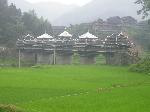
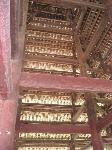
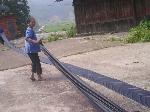
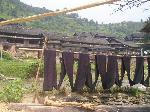
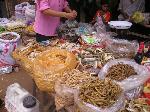
 Copyright © 1998-2026 All rights reserved.
Copyright © 1998-2026 All rights reserved.